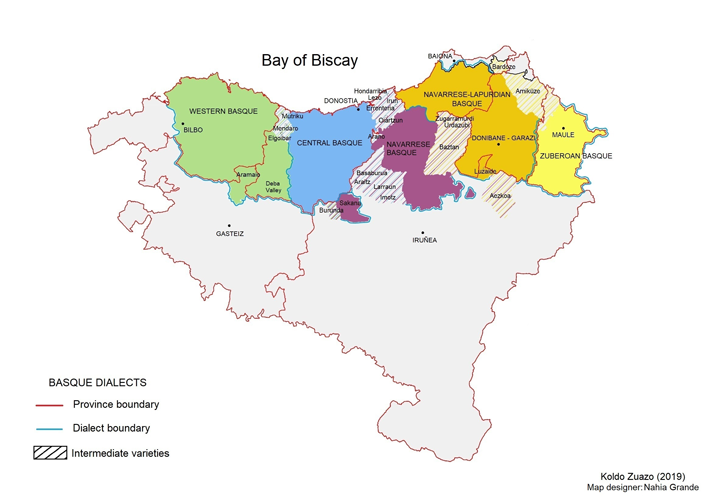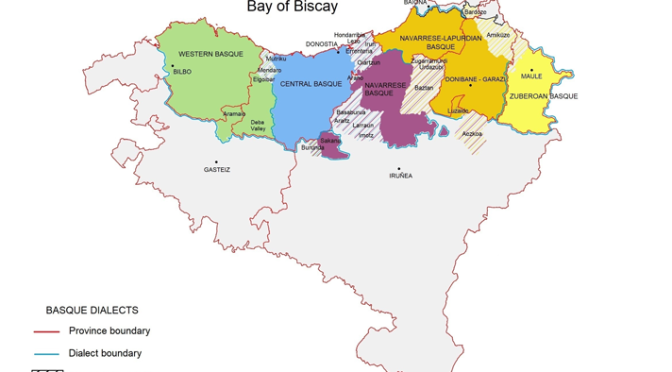One of the challenges I had when I tried to learn Euskara in Donostia was that I was learning Batua but when I went to visit my dad’s family, they spoken the Bizkaian dialect and I had a hard time understanding them. When I told my dad about it, he nodded, saying he couldn’t understand the Basque from Iparralde. Indeed, it almost seems that every valley, every baserri, has its own dialect of Euskara. One of the goals of standardizing Basque is to make communication in the language easier, but of course that comes with loss of richness of the language.

- The person who really established the distribution of Basque dialects was Prince Luis Luciano (or Louis Lucien) Bonaparte, a nephew of Napoleon. Bonaparte was fluent in multiple dialects of Basque, extensively traveling the Basque Country and delineating boundaries between the dialects. By 1869, he had determined that there were 3 large groups of the Basque language, within which there were 8 dialects, 25 sub-dialects, and an astonishing 50 varieties.
- Group A is primarily Bizkaian. Within this group, Bonaparte identified three sub-dialects, an oriental dialect representative of the Basque spoken in Markina, an occidental dialect typical of towns like Gernika, Bermeo, and Arrigorriaga, and a “Gipuzkoan” dialect of Bergara and Salinas.
- The second group is much larger and comes from Gipuzkoa, Nafarroa, and Lapurdi, giving us 4 dialects and 14 sub-dialects. Like Bizkaian, Gipuzkoan is split into 3 sub-dialects, but the two “high Nafarroan” dialects split into split into 9 sub-dialects.
- The last group comes from Nafarroa Beherea and Zuberoa in Iparralde. In this group, Bonaparte again identified 3 dialects, comprised of another 8 sub-dialects.
- Ultimately, then, Bonaparte classified Euskara into 8 dialects: Bizkaian, Gipuzkoan, Northern Upper Nafarroan, Lapurdian, High Southern Nafarroan, Zuberoan, Eastern Lower Nafarroan, and Western Lower Nafarroan.
- Today, there are five primary dialects recognized by researchers of Euskara, as classified in 1998 by linguist Koldo Zuazo: Bizkaian, Gipuzkoan, Upper Nafarroan, Nafarroa-Lapurdian, and Zuberoan. These regions are connected by transition regions in which variants of the language include feature from two different dialects. Zuazo further notes that all of the Basque dialects have similar influences from Latin, suggesting they all diverged after contact with the Romans. Zuazo maintains the site Euskalkiak.eus, which discusses in more depth the origins and features of the various Basque dialects.
- A number of features define the different dialects, but broadly they can be classified into three major changes. In the southern dialects, there has been a loss of the /h/ and the associated aspirated stops. The sound /j/ (think of the y in English yes) has turned into a variety of other sounds, including /ɟ/ (y as in Spanish yo), /ʒ/ (s as in pleasure), /ʃ/ (sh as in she), or /x/ (ch as in loch). Finally, the Zuberoan dialect has developed the vowel /y/, not really present in English or Spanish nor the other dialects of Basque. You can find a lot more information about the features that define each dialect at Euskalkiak.eus.
Primary sources: Auñamendi Entziklopedia. DIALECTO. Available at: https://aunamendi.eusko-ikaskuntza.eus/en/dialecto/ar-44516/; Basque dialects, Wikipedia; Euskalkiak.eus
Discover more from Buber's Basque Page
Subscribe to get the latest posts sent to your email.



Quite informative Blas, mila ezker.
Ez horregatik, Joseba!